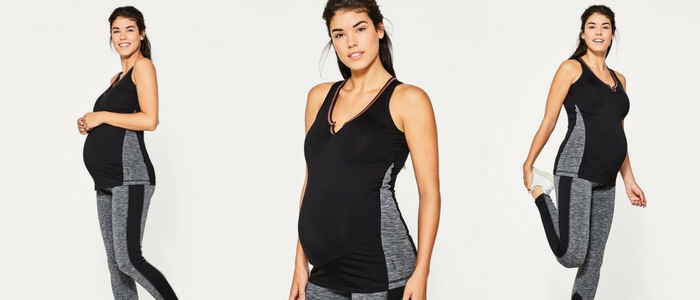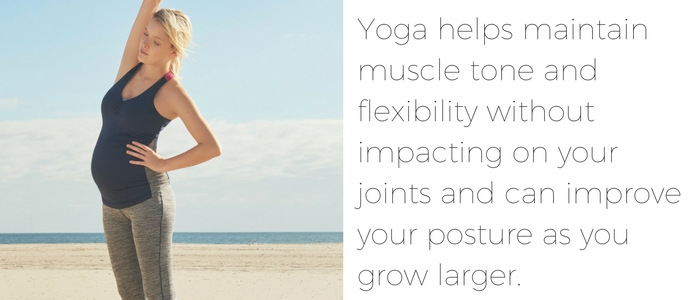
Worried or unsure about exercising while pregnant? We’re here to reassure you. Whether you’ve exercised rarely or regularly before falling pregnant, studies confirm that adopting a prenatal exercise regime can be beneficial not only for you, but for your developing baby as well.
Exciting right! But there are a few things you should know before getting your sweat on. This guide looks at the benefits of prenatal exercise, the types of exercise you can try and how to exercise safely while preparing for your baby’s arrival. Of course, always consult your doctor beforehand to make sure the exercises are right for you.
Why exercising while pregnant is so beneficial
There are numerous benefits associated with exercising while pregnant, both for you and for your baby.
- Greater stamina for labour
Prenatal exercise helps prepare you for childbirth by strengthening your muscles and increasing your physical endurance.
- Adapting more successfully to extra weight
Staying fit will help you to carry the weight you gain during pregnancy.
- Reducing the risk of complications
Exercise can help prevent and manage complications such as urinary incontinence, hypertension and pre-eclampsia. It can also reduce the risk of having a caesarean by 15%.
- Improved mood and sense of wellbeing
You can reduce the risk of developing anxiety and depression with regular exercise.
Exercise can also increase the speed at which your body bounces back into shape once your baby is born.
Regular exercise classes gives you the chance to meet and socialise with other mums-to-be.

Which exercises are best for pregnant women?
Sadly, most pregnant women don’t meet the active guidelines of 150 minutes a week or 30 minutes a day to obtain these health benefits and there is evidence that activity levels decrease overall during pregnancy.
Seek the advice of a healthcare professional so you can get started in a prenatal exercise regime as soon as you can. There are plenty of low-impact forms of exercise that help already healthy people stay fit during pregnancy.
Yoga helps maintain muscle tone and flexibility without impacting on your joints and can improve your posture as you grow larger. Yoga also helps to promote relaxation and an increased sense of wellbeing, but make sure your yoga instructor is experienced in providing advice for pregnant women.
Pilates incorporates flexibility, strength training, breathing rhythms and relaxation, making it an ideal exercise during pregnancy. It also strengthens your stomach and pelvic floor muscles, two areas that can become weakened when pregnant, and helps to create a stable core for birthing.
Swimming exercises your limbs and works your heart and lungs in complete weightlessness, making it a safe and low-impact way to exercise when pregnant. Aquanatal classes can also help with pregnancy side effects such as back pain and swelling in your legs.
Walking is the perfect cardiovascular exercise for pregnant women, as it is low impact and you can do as much or as little as you want. Always warm up prior to walking with exercises such as leg swings and arm and ankle circles. You should try to walk at least 30 minutes a day, five times a week.
Dancing is a non-strenuous exercise for pregnant women that can be done anywhere, although moves involving jumping, spinning, or sudden changes of direction should be avoided.
Tips for exercising safely
1. Adjust your exercise regime throughout your pregnancy
While these forms of exercise are safe during pregnancy, some may not be suitable in the last few months and you might have to reduce the intensity as your pregnancy progresses. Again, your doctor or midwife is the best one to consult regarding this.
2. Be aware of bodily changes
It’s important to be aware that your body will undergo lots of changes during your pregnancy and some of these may require you to modify how you go about exercising. For example:
- Hormones like ‘relaxin’ which loosen ligaments could increase your risk of joint injuries while exercising.
- Your body shape will change, moving your centre of gravity forward, which could affect your balance and coordination.
- Your blood pressure will drop in the second trimester, which may cause dizziness if you lie down or stand up too quickly.
3. Learn what exercises to avoid
Exercises that should be avoided while you are pregnant include:
- Activities involving abdominal trauma or pressure such as weightlifting
- Contact sports such as martial arts, soccer or basketball
- Sports involving hard projectile objects such as hockey, cricket or softball
- Activities where falling is possible such as skiing, horse riding, cycling or skating
- Activities requiring extreme balance, coordination and agility like gymnastics
- Activities involving major pressure changes such as scuba diving
- Activities involving heavy lifting
- Activities at altitudes over 2,000 metres above sea level
- Exercise positions involving lying on your back for long periods
- Any activity involving wide squats or lunges
If you are exercising while pregnant and you experience headaches, dizziness, heart palpitations, chest pain, swelling, bleeding, leakage, cramping, contractions, muscle weakness or shortness of breath, you should stop exercising immediately and see your doctor.
4. Know when to stop
Given that your body is undergoing such traumatic changes during pregnancy, you should try to ensure that when exercising you don’t overheat, always stay well hydrated, never exercise to the point of exhaustion, avoid overextending your muscles, don’t exercise if you are feeling unwell and always work at less than 75% of your maximum heart rate.
And as for how long you should continue exercising into your pregnancy, Sports Medicine Australia (SMA) advises trainers that during the 1st trimester, a mother’s heart rate should be kept low, so low intensity fat burning exercises are recommended. They say the 2nd trimester is the best time to train, as you are no longer sick, are sleeping better and haven’t yet become too big. And in the 3rd trimester, you should have no more than three sessions of vigorous exercise a week, with training depending entirely on the individual.
Exercise clothes for pregnant women
Exercise during pregnancy is not only good for you and your baby, but it can be great fun as well, so make sure you choose an activity that you enjoy. Stay comfortable wearing Queen Bee active garments to keep you cool, comfortable and stylish during your exercise routines.
Our Activewear Boutique has a comprehensive range of clothes for active mums-to-be from maternity yoga wear and lounge wear to track suits, sweatshirts, leggings and hoodies. You’ll find all the leading maternity brands including Noppies, Blanqi, Trimester and Maternal America, along with a stylish range of gym wear from Belabumbum.
So stay healthy and keep moving during your pregnancy and check out Queen Bee’s fabulous activewear range here.
